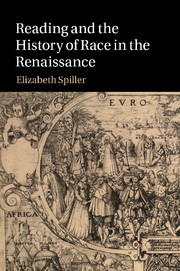Book contents
- Frontmatter
- Contents
- Acknowledgements
- Introduction: Print Culture, the Humoral Reader, and the Racialized Body
- 1 Genealogy and race after the Fall of Constantinople: From The King of Tars to Tirant lo Blanc and Amadis of Gaul
- 2 The form and matter of race: Aethiopika, hylomorphism, and neo-Aristotelian readers
- 3 The conversion of the reader: Ariosto, Herberay, Munday, and Cervantes
- 4 Pamphilia's black humor: reading and racial melancholy in the Urania
- Notes
- Index
2 - The form and matter of race: Aethiopika, hylomorphism, and neo-Aristotelian readers
Published online by Cambridge University Press: 01 June 2011
- Frontmatter
- Contents
- Acknowledgements
- Introduction: Print Culture, the Humoral Reader, and the Racialized Body
- 1 Genealogy and race after the Fall of Constantinople: From The King of Tars to Tirant lo Blanc and Amadis of Gaul
- 2 The form and matter of race: Aethiopika, hylomorphism, and neo-Aristotelian readers
- 3 The conversion of the reader: Ariosto, Herberay, Munday, and Cervantes
- 4 Pamphilia's black humor: reading and racial melancholy in the Urania
- Notes
- Index
Summary
What began in the 1490s as Montalvo's attempt to create a form of romance that would counter the new definitions of race that emerged out of the Inquisition and church policies on conversion ended in Paris in the 1540s with Nicolas de Herberay's reconception of these racial and religious arguments in his widely read French translations of the cycle. The next important romance that Renaissance readers turned to for questions about the nature of race and identity was Heliodorus' Aethiopika. The Aethiopika was written c. ad 250; it appeared in both Greek and Latin editions (editio princeps, 1534), but most Renaissance readers first encountered the Aethiopika through Jacques Amyot's L'Histoire Aethiopique de Heliodorus (Paris, 1547). Amyot's presentation of Heliodorus was enormously influential in the development of sixteenth-century romance and, perhaps more importantly, in the development of sixteenth-century genre theory. Amyot introduced his translation of Heliodorus as a morally and intellectually acceptable alternative to the Amadis romances that, as we shall see, were intensely popular at the French court through the middle of the sixteenth century.
The Aethiopika was, for Amyot, exemplary largely because in both its form and its subject this romance promoted a new kind of reading and, with that, a different kind of reader. Amyot's aesthetic assessment of Heliodorus emerged out of the way in which Renaissance understandings of Aristotelian poetic theory were inflected through the then more familiar terms of Aristotelian physics.
- Type
- Chapter
- Information
- Reading and the History of Race in the Renaissance , pp. 79 - 111Publisher: Cambridge University PressPrint publication year: 2011

